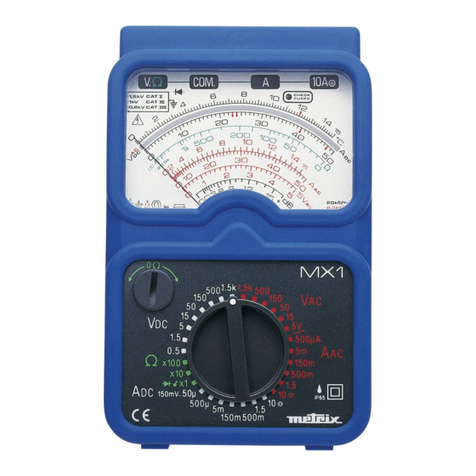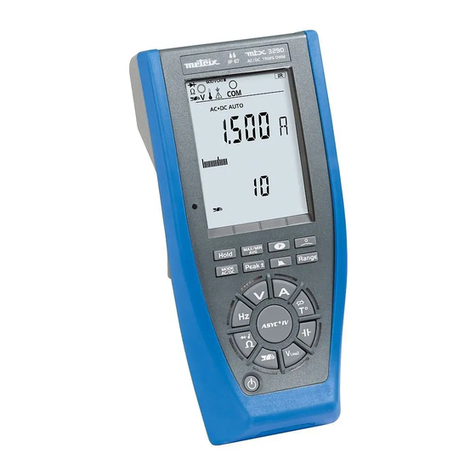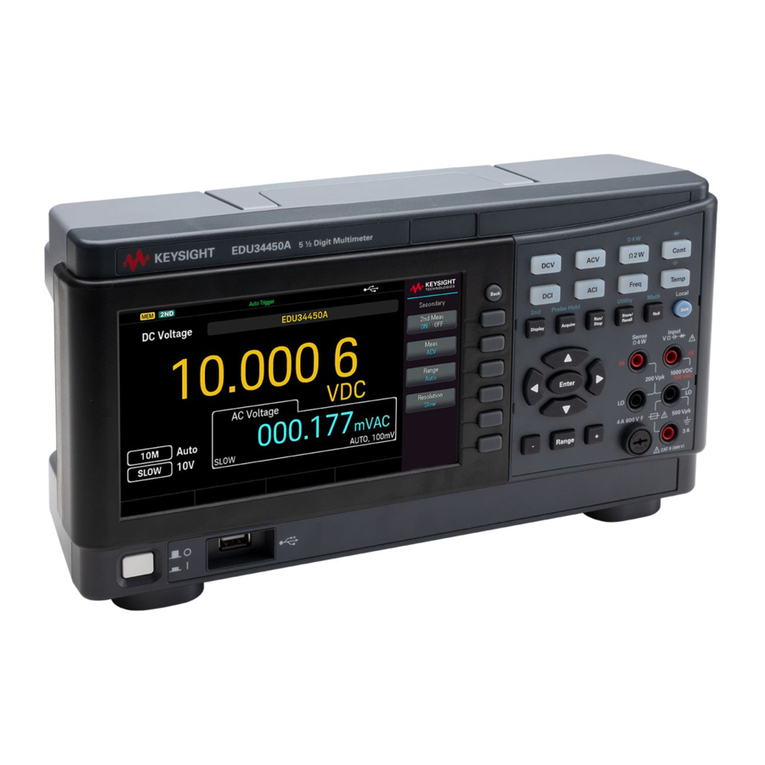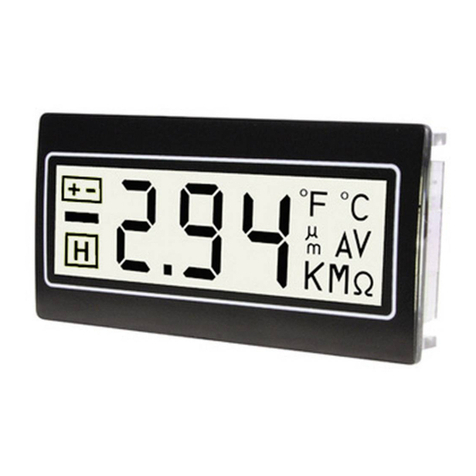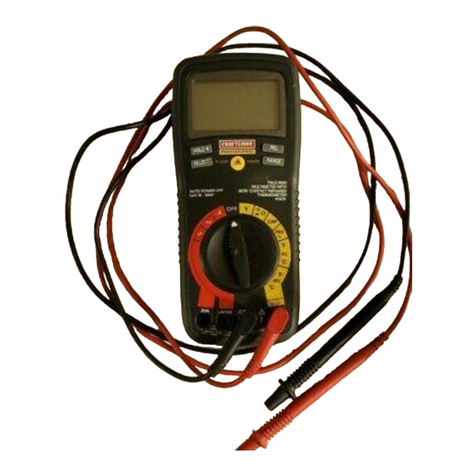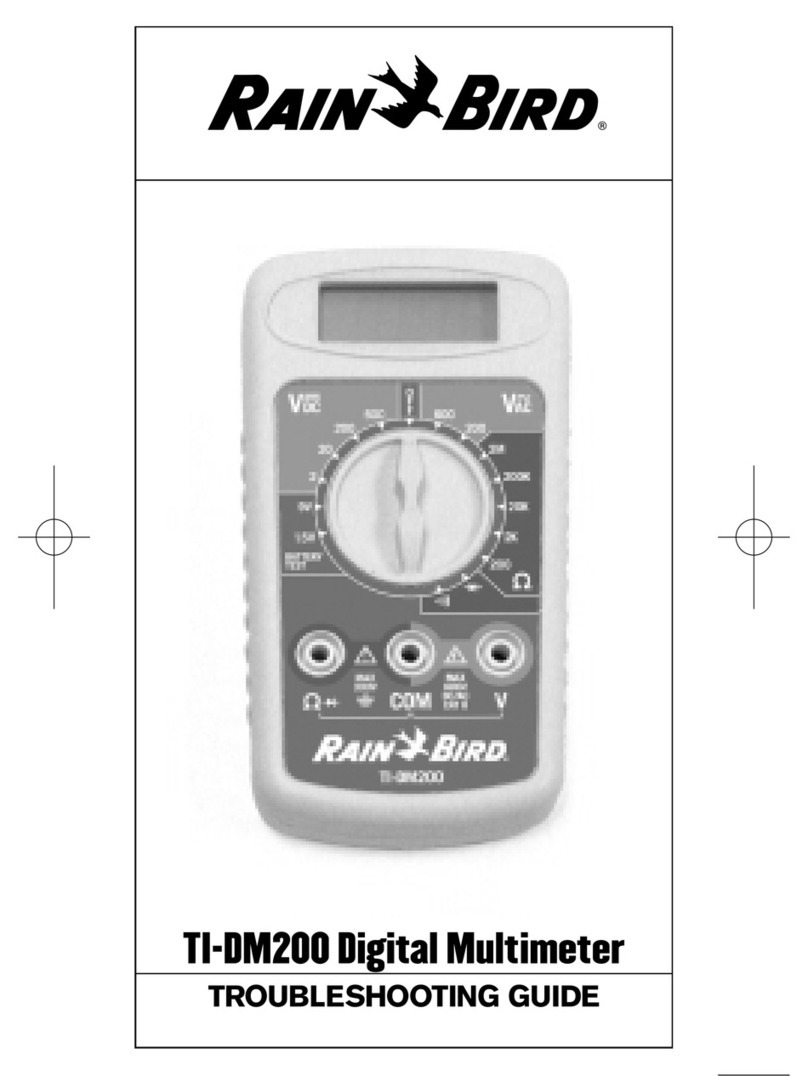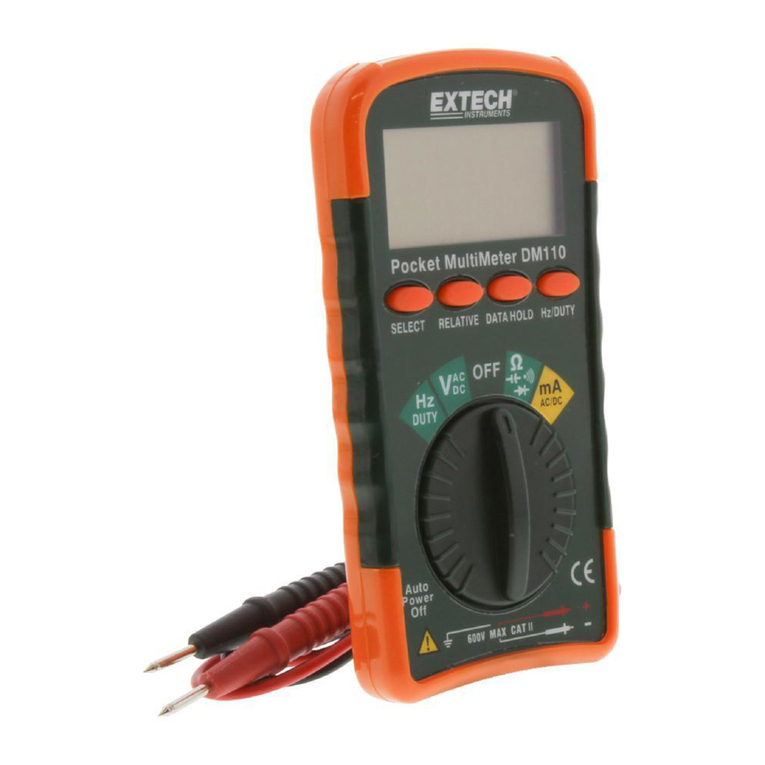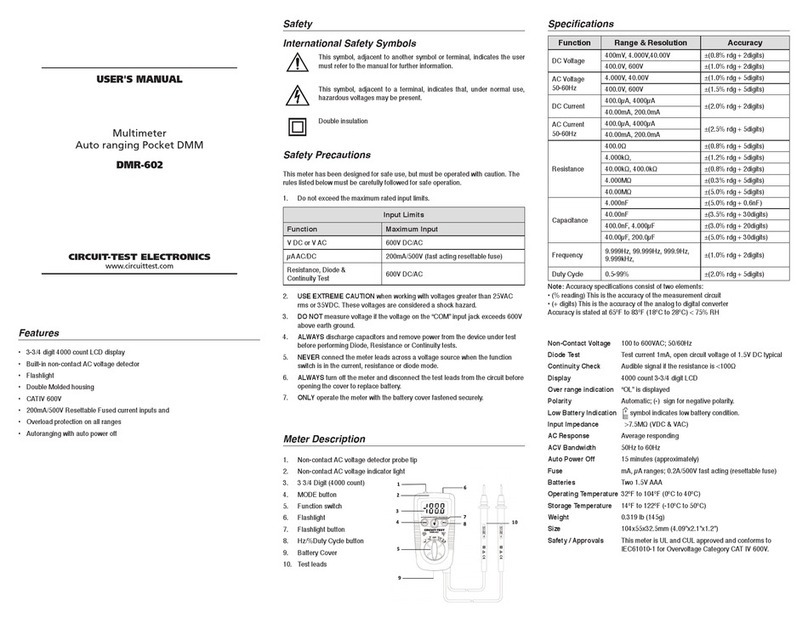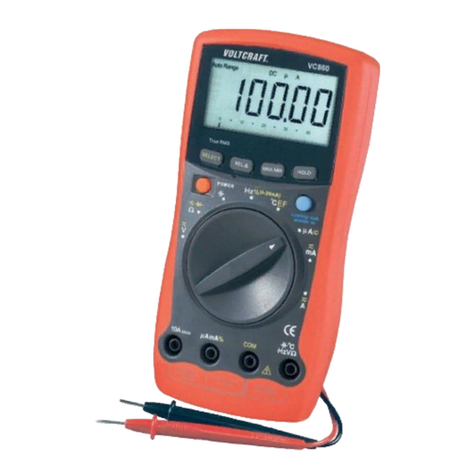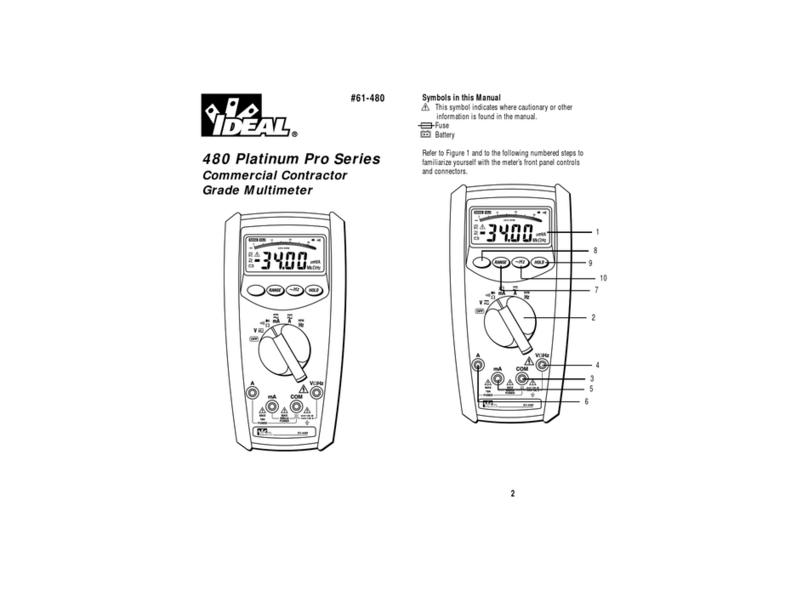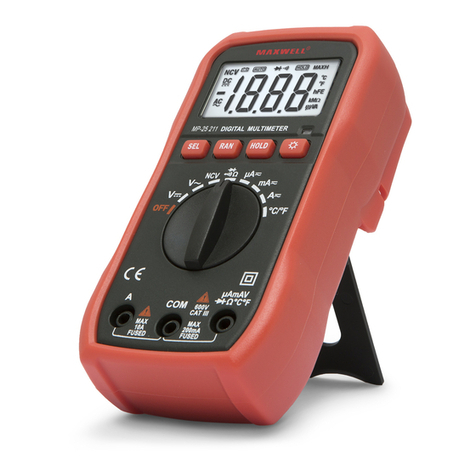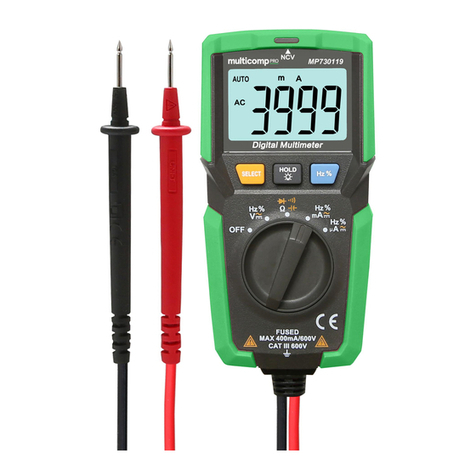Metrix MX 5060 User manual

B
B
Be
e
en
n
nc
c
ch
h
ht
t
to
o
op
p
p
M
M
Mu
u
ul
l
lt
t
ti
i
im
m
me
e
et
t
te
e
er
r
rs
s
s
M
M
MX
X
X
5
5
50
0
00
0
06
6
6
-
-
-
6
6
60
0
00
0
00
0
0p
p
pt
t
ts
s
s
M
M
MX
X
X
5
5
50
0
06
6
60
0
0
-
-
-
6
6
60
0
00
0
00
0
00
0
0p
p
pt
t
ts
s
s
U
U
Us
s
se
e
er
r
r'
'
's
s
s
M
M
Ma
a
an
n
nu
u
ua
a
al
l
l
Pôle Test et Mesure CHAUVIN ARNOUX
Parc des Glaisins
6, avenue du Pré de Challes
F -74940 ANNECY-LE-VIEUX
Tel. +33 (0)4.50.64.22.22 -Fax +33 (0)4.50.64.22.00
X03965A01 - Ed. 01 - 04/13

General directions
2 Benchtop multimeters, 6000 and 60000 points
Contents
General directions............................................................................................................................................ 3
Introduction.................................................................................................................................................................... 3
Precautions and safety measures ................................................................................................................................. 3
Symbols on the instrument ............................................................................................................................................ 4
Warranty........................................................................................................................................................................ 5
Maintenance, metrological verification........................................................................................................................... 5
Unpacking, repacking.................................................................................................................................................... 5
Repair under warranty ................................................................................................................................................... 5
Service............................................................................................................................................................... 6
Maintenance.................................................................................................................................................................. 6
Replacing the fuse......................................................................................................................................................... 6
Prop............................................................................................................................................................................... 6
Communication interface............................................................................................................................................... 6
Description of the instruments....................................................................................................................... 7
MX 5006, MX 5060 front panel...................................................................................................................................... 7
MX 5006, MX 5060 back ............................................................................................................................................... 7
Functional description..................................................................................................................................... 8
Display unit.................................................................................................................................................................... 8
Switch...........................................................................................................................................................................10
Keypad .........................................................................................................................................................................11
Preparation for use.......................................................................................................................................................16
How are the various quantities measured? ................................................................................................ 17
1. Voltage measurement ..............................................................................................................................................17
2. Current measurement...............................................................................................................................................18
3. Frequency measurement..........................................................................................................................................19
4. Resistance measurement........................................................................................................................................ 19
5. Audible continuity measurement...............................................................................................................................19
6. Diode test .................................................................................................................................................................20
7. Capacitance measurement.......................................................................................................................................20
8. Temperature measurement ......................................................................................................................................21
9. Measurement on an MLI type speed variator ...........................................................................................................22
Technical characteristics of MX 5006 .......................................................................................................... 23
Technical characteristics of MX 5060 .......................................................................................................... 30
General characteristics ................................................................................................................................. 38
Environmental conditions .............................................................................................................................................38
Power supply................................................................................................................................................................38
Display..........................................................................................................................................................................38
Safety ...........................................................................................................................................................................38
CEM .............................................................................................................................................................................38
Mechanical characteristics ........................................................................................................................... 38
Housing ........................................................................................................................................................................38
Supply.............................................................................................................................................................. 39

General directions
Benchtop multimeters, 6000 and 60000 points 3
General directions
Introduction
Congratulations! You are the new owner of a benchtop multimeter.
We thank you for this sign of confidence in the quality of our products.
The line of instruments to which it belongs comprises the following models:
MX 5006 6000pts TRMS -
MX 5060 60000pts TRMS USB Range 60mV
It complies with safety standard NF EN 61010-1 + NF EN 61010-2-030
concerning electronic measuring instruments.
For best results, read this manual closely and observe the precautions of use.
Failure to observe these warnings and/or directions may damage the instrument
and/or its components and may endanger the user.
Precautions and
safety measures
•This instrument is been designed to be used as follows:
-indoors
-in an environment of pollution degree 2
-at an altitude of less than 2000m
-at a temperature between 0°C and 40°C
-at a relative humidity below 80% up to 35°C.
•The safety of any system incorporating the instrument is the responsibility
of the system integrator.
•It can be used for measurements on 1000V, CAT III and 600V, CAT IV
circuits and can be supplied by a 230V ±10% AC network (230V CAT II).
However, some accessories may lead to the use of this instrument on
circuits of a lower voltage and category.
before
use
•Comply with the environmental and storage conditions.
•Check the integrity of the guards and insulation of the accessories. Any item
of which the insulation is deteriorated (even partially) must be removed from
service and scrapped. A change of colour of the insulation is a sign of
deterioration.
•Supply: make sure that the power cord supplied with the instrument is in
good condition. It must be connected to line power (230V ±10%, 600V,
CAT IV), (US version: 110V ±10%)
•The removable power cords must be replaced by cords having the
appropriate rated characteristics.
during
use
•Read closely all notes preceded by the symbol.
•The instrument's power supply has an electronic protection device that
resets automatically after the fault disappears.
•As a safety measure, use only the appropriate leads and accessories
supplied with the instrument or approved by the manufacturer.

General directions
4 Benchtop multimeters, 6000 and 60000 points
General directions (continued)
Definitions of the
measurement
categories
CAT II: Test and measurement circuits directly connected to the points of use
of the low-voltage network (power outlets and other similar points).
E.g.: Measurements on the network circuits of household appliances, portable
tools, and similar devices.
CAT III: Test and measurement circuits connected to parts of the low-voltage
network of the building.
E.g.: Measurements on distribution panels (including secondary meters), circuit-
breakers, wiring including cables, bus bars, branch boxes, disconnecting
switches, power outlets in the fixed installation, and industrial appliances and
other equipment, such as motors permanently connected to the fixed
installation.
CAT IV: Test and measurement circuits connected to the source of the low-
voltage network of the building.
E.g.: Measurements on devices installed before the main fuse or the circuit-
breaker of the building installation.
Warning! Using a measuring instrument, a lead, or an accessory belonging to a lower
measurement or voltage category derates the resulting system (instrument
+ leads + accessories) to the lowest measurement category and/or service
voltage of any of the components.
Symbols on the
instrument
Risk of electric shock: directions for connection and disconnection of the inputs.
Always connect the probes or adapters to the instrument before connecting them
to the measurement points. Always disconnect the probes or cords from the
measurement points before disconnecting them from the instrument. These
directions apply before the instrument is cleaned.
Warning: Hazard. The operator must refer to the manual each time this danger
symbol is encountered.
Double insulation
Earth
In the European Union, this product is subject to selective collection for the
recycling of electrical and electronic equipment waste in accordance with
Directive WEEE 2002/96/EC: this equipment must not be treated as ordinary
waste. The spent batteries must not be treated as ordinary waste. Take them in
to the appropriate collection point for recycling.
The CE marking indicates conformity with the European "Low Voltage", "EMC",
"WEEE" and "RoHS" directives.
USB (MX 5060, only)

General directions
Benchtop multimeters, 6000 and 60000 points 5
General instructions (continued)
Warranty
This equipment is warranted for 3 years against any defect of materials or
workmanship, in accordance with the general terms of sale. During the
warranty period, the instrument may be repaired only by the manufacturer, who
reserves the right to repair the instrument or to replace it or part of it. If the
equipment is returned to the manufacturer, the cost of transport to the
manufacturer is borne by the customer.
The warranty does not apply following:
•improper use of the equipment or use in association with incompatible
equipment
•modification of the equipment without the explicit permission of the
manufacturer's technical staff
•maintenance done by a person not approved by the manufacturer
•adaptation to a particular application not anticipated in the definition of the
equipment or by the user manual
•a shock, a fall, or flooding.
Maintenance,
metrological
verification
Before opening the instrument, you must disconnect it from line power and
from the measurement circuits and make sure that you are not charged with
static electricity, which might destroy internal components. An adjustment,
maintenance, or repair of the live instrument must be undertaken only by
personnel who are qualified and have familiarized themselves with the
directions in this manual.
This instrument should be checked at least once a year. For checking and
calibration, contact one of our accredited metrology laboratories (information
and contact details available on request), at our Chauvin Arnoux subsidiary or
the branch in your country.
Unpacking,
repacking
All of the equipment has undergone mechanical and electrical checks before
being dispatched. When you receive it, carry out a quick check to detect any
deterioration that may have occurred during transport. Should the need arise,
immediately contact our sales department and notify the carrier of the customary
reservations.
Use the original packaging to reship the equipment, if possible. Indicate as
clearly as possible, by a note attached to the equipment, the reasons for the
transfer.
Repair
under warranty and
post warranty
For all repairs before or after expiry of warranty, please return the device to your
distributor.

Service
6 Benchtop multimeters, 6000 and 60000 points
Service
Maintenance
•Disconnect everything connected to the instrument and set the switch to
“OFF”.
•Use a soft cloth, moistened with soapy water.
Rinse with a damp cloth and dry rapidly with a dry cloth or forced air.
•Make sure that no foreign objects interfere with the operation of the device
by which the leads are snapped into place.
Replacing
the fuse
•Before replacing the fuse, disconnect the instrument from any source of
current.
•Checking the current fuse:
1. Set the switch to .
2. Connect the V socket to the 10A
socket; leave the "COM" socket open.
3. The display unit must indicate a result
< 2 , if not, replace the fuse.
•Access to and location of the fuse, by opening
the housing:
•Current protection: fuse, 11A, 1000V > 20kA (10x38)
•Power supply protection: PTC
Tilt stand The tilt stand/handle has 2 blue pushbuttons on the sides that are used to
unlock it:
•Press the pushbuttons simultaneously
•Adjust the prop to the desired position
•Release the 2 pushbuttons to lock the handle in position
Communication
interface
The MX 5060 has a USB communication interface, used:
•to configure and read the data measured by the instrument (using SX-
DMM software),
•to recalibrate the instrument.
*The MX5006 does not have a USB communication port. Only an RS link
is available to calibrate the instrument (after opening it).

Description of the instruments
Benchtop multimeters, 6000 and 60000 points 7
Description of the instruments
Front panel
MX 5006
LCD (6000pts) Keypad Switch Terminal block
MX 5060
LCD (60000pts) Keypad Switch Terminal block
Rear panel
MX 5006
Reminders Switch Power connector,
ON/OFF 110V or 230V
MX 5060
Pushbuttons of
the tilt stand Insulated USB port Pushbuttons of the tilt stand

Functional description
8 Benchtop multimeters, 6000 and 60000 points
Functional description
Display unit
MX 5006
double display
6000pts
MX 5060
double display
60000pts
Quantities
measured
•V
LowZ AC voltage measurement at low impedance (VLowZ)
•V
AC AC voltage measurement
•V
AC/DC DC or AC+DC voltage measurement at high impedance (V)
•A Current measurement A
•Hz Frequency measurement
•Resistance measurement
•µF Capacitance measurement
•T° Temperature measurement
•ms Measurement of the period
•% Measurement of relative value
Units •V Volt
•A Ampere
•Hz Hertz
•Ohm
•F Farad
•°F Degree Fahrenheit
•°C Degree Celsius
•ms millisecond
•k kilo (k- kHz)
•M Mega (M- MHz)
•n nano (nF)
•µ micro (µV- µA - µF)
•m milli (mV- mA - mF)
•% Percentage

Functional description
Benchtop multimeters, 6000 and 60000 points 9
Functional description (continued)
Symbols Designation
AC Measurement of the RMS AC signal
DC Measurement of the DC signal
AC + DC Measurement of the TRMS AC and DC signal
AUTO Automatic range switching
ΔREL Values relative to a reference
ΔMem Presence of a reference value in memory
HOLD Storage and display of stored values
MAX Maximum value
MIN Minimum value
PEAK+ Maximum peak value
PEAK- Minimum peak value
.run r.un ru.n Capacitance meter, acquisition in progress
----- Frequency measurement impossible
O.L Overshoot of the measurement capacities
V Volt
Hz Hertz
F Farad
°C °F Degree Celsius, degree Fahrenheit
A Ampere
% Percentage
ΩOhm
ms millisecond
n Symbol of the nano- prefix
μSymbol of the micro- prefix
m Symbol of the milli- prefix
k Symbol of the kilo- prefix
M Symbol of the mega- prefix
Symbol of the audible continuity measurement
Symbol of the measurement and testing of a semiconductor junction
Warning, possibility of electric shock (∗)
USB communication
300Hz MLI filter
(∗)When voltages exceeding 60 VDC or 25 VAC are measured, the symbol flashes on the display unit.

Functional description
10 Benchtop multimeters, 6000 and 60000 points
Functional description (continued)
Switch
The switch setting determines the measurement function chosen. The
rotation of the switch has priority over key presses. The change from one
position to another resets the configuration of the measurement mode.
The change from one measurement function to another deactivates the
key, if the HOLD mode was selected.
The switch has 10 positions:
3 2 1 4 5 6 7 8 9 10
1. OFF mode - Switches the multimeter off
2. AC voltage measurement at low impedance (VLowZ)
3. RMS AC voltage measurement
4. DC or AC+DC voltage measurement at high impedance (V)
5. Frequency measurement
6. Capacitance measurement
7. Resistance measurement, audible continuity measurement,
diode test
8. Temperature measurement T, K
9. Current measurement A (AC, DC, or AC+DC)
10. OFF mode - Switches the multimeter off

Functional description
Benchtop multimeters, 6000 and 60000 points 11
Functional description (continued)
Keypad
The keypad has the following function keys:
MODE AC/DC
RANGE
MAX/MIN/PEAK
ΔREL
HOLD
MLI bandwidth filter ( )
The keys are taken into account and applied when pressed. If the key press is
validated, the instrument beeps.
General rules
For the keys, 2 types of possible action are distinguished:
•Short press: key press lasting less than 2 seconds, validated by a beep
as soon as the key press is detected.
•Long press: key press lasting more than 2 seconds, validated by a beep as
soon as the key press is detected.
Choice of coupling, AC, DC, AC+DC, of the bargraph style, or of the secondary
function key of the keypad (yellow).
Manual selection of the measurement range. The range defines the maximum
measurement span the instrument can cover.
*The Auto Range mode is activated as default.
Display of the MAX, MIN, PEAK+, or PEAK- mode:
•MAX and MIN display the highest and lowest value of the RMS
measurement.
•PEAK+ displays the maximum peak instantaneous value of the
measurement.
•PEAK- displays the minimum peak instantaneous value of the
measurement.
Storage of the measurements and quantities at a given time.
Freezes the display without stopping acquisition. The bargraph continues to
operate normally.
The key is used to deactivate back-lighting of the instrument.
Display and storage of the reference value of the differential value in the unit of
the quantity measured.
This key is used to limit the bandwidth to 300Hz.
Thanks to the low-pass filter (4th order), it is possible to measure the RMS
voltage delivered by an MLI type speed variator (for asynchronous motor).
See curves p. 29 and 37.

Functional description
12 Benchtop multimeters, 6000 and 60000 points
Functional description (continued)
Summary table
of the keys Successive short presses Long press
AC/DC MODE
-Choice of AC, DC, or AC+DC coupling
-Access to the second function (yellow marking
on the front panel)
-In the REL or MAX/MIN PEAK plus REL
mode, the key is used to go from
(present value - reference value) to
present value - reference value
reference value
The value is displayed in %.
Choice of bargraph style:
Bargraph graduated from
zero to full scale or
with central zero
RANGE
-Manual selection of the measurement range
-Exit from the MAX/MIN, PEAK mode
Exit from the manual mode to
return to auto range
(the default)
* MAX/MIN PEAK
(*)See example on p. 13
-1st press: recording of MAX, MIN, PEAK+,
PEAK- (on the 2nd display unit).
The max. value is displayed as default.
- Subsequent presses: look-up of recorded
values
Exit from the MAX/MIN PEAK
mode
HOLD
-Activation/deactivation of freezing of the
display. Acquisition continues as a
background task.
*In the MAX/MIN PEAK mode, when HOLD
is active, the blinking of the "MAX MIN PEAK"
symbol indicates that acquisition continues as
a background task.
On/off switching of the backlight
*ΔREL
(*) See example on p. 14
-1st press: activates the relative mode REL
(present value - reference value)
and stores the measured value, which will be
used as reference. “Mem” indicates storage
of the reference.
-Subsequent presses: toggles the display
between measured value, reference, and
relative measurement REL, reference for
look-up.
Exit from the REL mode and
erasure of the reference value
(the Mem symbol goes off)
Activation of the 300Hz bandwidth filter Activation/deactivation of the key-
press beep
The , , , ,,and functions can be accessed by successive short
or long presses on a key (see table above). The functions are not mutually exclusive; they can be
combined.
It is therefore possible to implement mAX/MIN PEAK in relative or pure relative only. Similarly, the HOLD
mode applies to all functions and does not interfere with mAX/MIN PEAK surveillance; all it does is freeze
the display. Each press is validated by an audible signal.
x 100

Functional description
Benchtop multimeters, 6000 and 60000 points 13
Functional description (continued)
MAX/MIN PEAK mode
Examples of display in
the VAC+DC function
Measured signal: 230V, 50Hz:
for the MAX value: First press on the key:
The measured signal changes to 250V, 50Hz:
for the MIN value: Second press on the key:
for the PEAK+ value:
Third press on the key:
for the PEAK- value: Fourth press on the key:
Present value of the signal
PEAK- value
Present value of the signal
MIN value
Present value of the signal
PEAK+ value
Present value of the signal
MAX value
Present value of the signal
MAX value
Present value of the signal
Frequency of the signal

Functional description
14 Benchtop multimeters, 6000 and 60000 points
Functional description (continued)
Mode ΔREL
Examples of display
in the VAC+DC
function
Measured signal: 1V, 100Hz:
Activation of the
Δ
REL mode by a short press on the key:
The signal changes to 1.5V (ΔREL = 1.5V-1V = 0.5V)
De-activation of the
Δ
REL mode by a press on the key:
A long press on the key erases the reference value and exits from the
ΔREL mode.
Short press, in the ΔREL mode, on the key:
Present value of the signal
Frequency of the signal
ΔREL = (present value - reference value)
Reference value
Present value - Reference value
ΔREL (%) = x 100
Reference value
ΔREL = (present value - reference value)
Reference value
Reference value
Present value of the signal
Reference value

Functional description
Benchtop multimeters, 6000 and 60000 points 15
Functional description (continued)
Functions
of the switch
and keys
To access the , , , , , , , and
functions, set the switch to the function chosen.
Here are the possible combinations according to the type of measurement:
Range
Type of measurement Max/Min Peak ± ΔREL
Auto. Manu.
HOLD
Voltage VLowZ
Voltage VAC
Voltage VAC+DC
Current AAC, AAC+DC
999in ΔREL
only 9999
Voltage VDC
Current ADC 9- 99999-
Voltage 60mVDC 9- 99- 99-
Voltage 60mVAC
Voltage 60mVAC+DC 999- 999
Temperature 9- 9999-
Ohmmeter 9- 9999-
Capacitance 9- 9999-
Frequency 9- 9
in ΔREL
only
9- 9-
Period (1/F) - - - - 9- 9-
Continuity - - - - 9- - -
Diode - - - - 9- 9-

Functional description
16 Benchtop multimeters, 6000 and 60000 points
Functional description (continued)
Preparation for use
Instructions before
starting up
When you use this multimeter, you must observe the usual safety rules,
which:
•protect you from electrical hazards,
•protect the multimeter from operator errors.
For your safety, use only the leads supplied with the instrument. Before
each use, make sure that they are in perfect condition.
Power supply line power at 230V ±10% (US version, 110V ±10%) ; 45Hz to 65Hz
The power connector is on the back of the instrument. (The earth connection
serves to carry currents to earth).
Powering up,
down
Use the power On/Off switch on the back of the instrument to power it up.
A check light on the front of the instrument indicates that it is powered up.
Switching on The switch is set to «OFF». Turn the switch to the function of your choice.
All segments of the display unit light for a few seconds, then the screen of
the function selected is displayed.
The multimeter is then ready to perform measurements.
*- Starting up accompanied by a simultaneous sustained press on the
HOLD key (until it beeps) lights all segments of the display unit
- A second, short, press displays:
•the hardware version (A, B, C, etc.),
•the software version
•the instrument model (MX 5006 or MX 5060).
- A third short press is used to exit from the mode.
Switching to standby Set the switch to “OFF”.

How are the various quantities measured?
Benchtop multimeters, 6000 and 60000 points 17
How are the various quantities measured?
1. Voltage
measurement
:AC voltage measurement, or measurement of an AC voltage
superposed on a DC voltage, or DC voltage measurement at high
impedance.
:AC voltage measurement at high impedance
: This position is provided to allow measurements in electrical
installations. The input impedance <1Mserves to avoid
measuring "phantom" voltages due to couplings between the lines.
In all cases, “O.L” is displayed above 1050V and a beep sounds when the
measurement exceeds 600V.
1. Set the switch to or or .
2. Select AC+DC or DC coupling of the signal by pressing (the
default coupling is AC+DC).
Depending on what you select, the screen displays DC or AC+DC.
3. Connect the black lead to the “COM”terminal and the red lead to “+”.
4. Place the test probes on the terminals of the circuit to be measured:
5. Read the measurement value indicated on the display unit.
6. As default, the 2nd display unit indicates the frequency, except in DC.
Remark: It is possible to activate the filter in VLowZ, V
AC+DC
, V
AC
.
The cutoff frequency of the filter is ≤300Hz.
When a voltage having a frequency above 150Hz is
measured, it is heavily attenuated, and so a large error may
be observed. It is necessary in this case to deactivate the
filter to have the full bandwidth.

How are the various quantities measured?
18 Benchtop multimeters, 6000 and 60000 points
How are the various quantities measured? (continued)
2. Current
measurement 1. Set the switch to .
2. Select the type of signal, AC+DC, AC, or DC, by pressing .
Depending on what you select, the screen displays AC, DC, or AC+DC.
3. Connect the black lead to the “COM” terminal and the red lead to “A”.
4. Place the test probes in series between the source and the load:
5 Read the measurement value indicated on the display unit.
“O.L” is displayed, if I>20A.
6 As default, the 2nd display unit indicates the frequency, except in DC.
Remark: It is possible to activate the filter in AAC+DC, AAC.
The cutoff frequency of the filter is ≤300Hz.
When a voltage having a frequency above 150Hz is
measured, it is heavily attenuated, and so a large error may
be observed. It is necessary in this case to deactivate the
filter to have the full bandwidth.

How are the various quantities measured?
Benchtop multimeters, 6000 and 60000 points 19
How are the various quantities measured? (continued)
3. Frequency
measurement 1. Set the switch to .
2. Connect the black lead to the “COM” terminal and the red lead to “+”.
3. Place the test probes on the terminals of the circuit to be measured.
*Connect the instrument as for a voltage measurement
4. Read the measurement value indicated on the display unit.
5. Press to obtain the period of the signal 1/F (ms).
4. Resistance
measurement 1. Set the switch to .
2. Connect the black lead to the “COM” terminal and the red lead to “+”.
3. Place the test probes on the terminals of the component.
Remark: Resistance measurements must be made with power off.
However, while the presence of a voltage will prevent or throw
off the measurement, it will not damage the instrument.
4. Read the measurement value indicated on the display unit.
5. “O.L” is displayed, if the circuit is open.
5. Audible
continuity
measurement
1. Set the switch to .
2. Press ; the “ ” symbol is displayed.
3. Connect the black lead to the “COM” terminal and the red lead to “+”.
4. Place the test probes on the terminals of the circuit to be measured.
*Connect the instrument as for a voltage measurement.
5. Read the measurement value indicated on the display unit.
6. The continuity beep sounds when R<30±3.
7. “O.L” is displayed, if the circuit is open.

How are the various quantities measured?
20 Benchtop multimeters, 6000 and 60000 points
How are the various quantities measured? (continued)
6. Diode test 1. Set the switch to .
2. Press twice; the “ ” symbol is displayed.
3. Connect the black lead to the “COM” terminal and the red lead to “+”.
4. Place the test probes on the terminals of the component:
5. Read the measured threshold voltage of the junction indicated
on the display unit.
6. “O.L” is displayed, if the circuit is open or the threshold of the diode >3V.
7. Capacitance
measurement 1. Set the switch to .
2. Connect the black lead to the “COM” terminal and the red lead to “+”.
3. Place the test probes on the terminals of the component:
4. Read the measurement value indicated on the display unit.
“O.L” is displayed, if the value to be measured exceeds the capacitance of
the range.
“O.L” is displayed, if the capacitor is short-circuited.
¾For high values, the measurement cycle includes the display of "run" with
a "chaser" decimal point. This means that acquisition is in progress; wait
for the display of the digital result.
"Run" is displayed immediately, if the previous measurement
was in a small range.
¾The prior discharge of very high capacitances helps shorten the
measurement time.
This manual suits for next models
1
Table of contents
Other Metrix Multimeter manuals
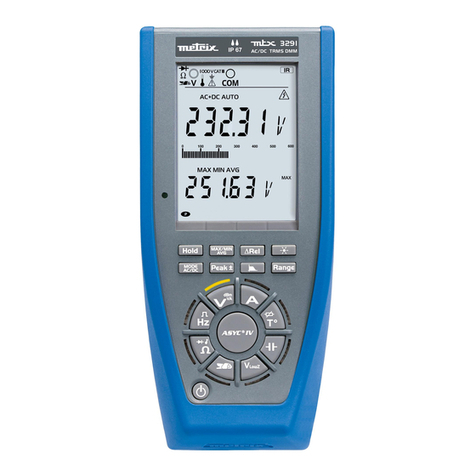
Metrix
Metrix MTX 3290 User manual
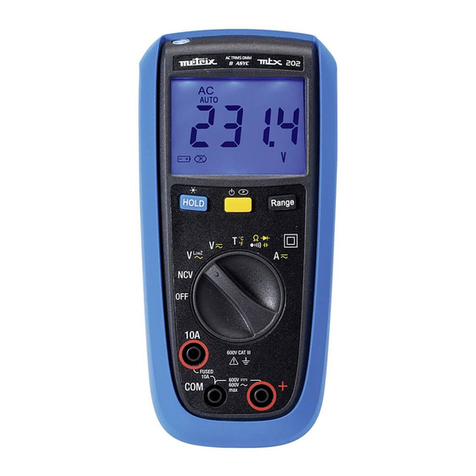
Metrix
Metrix MTX 202 User manual

Metrix
Metrix MX 58HD User manual
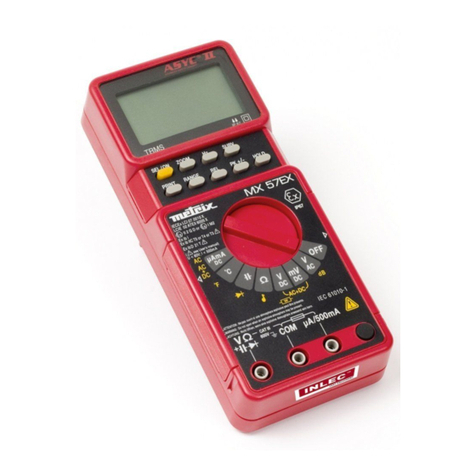
Metrix
Metrix MX 57 EX User manual
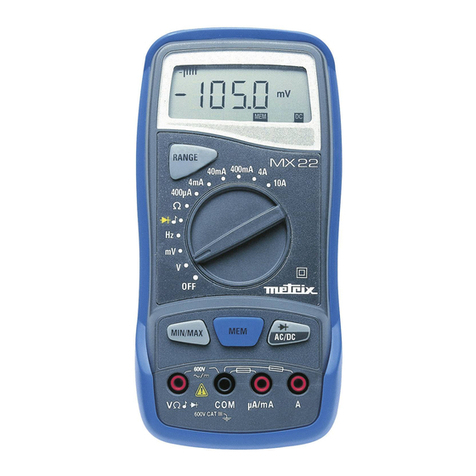
Metrix
Metrix MX 22 User manual

Metrix
Metrix MX 1 User manual
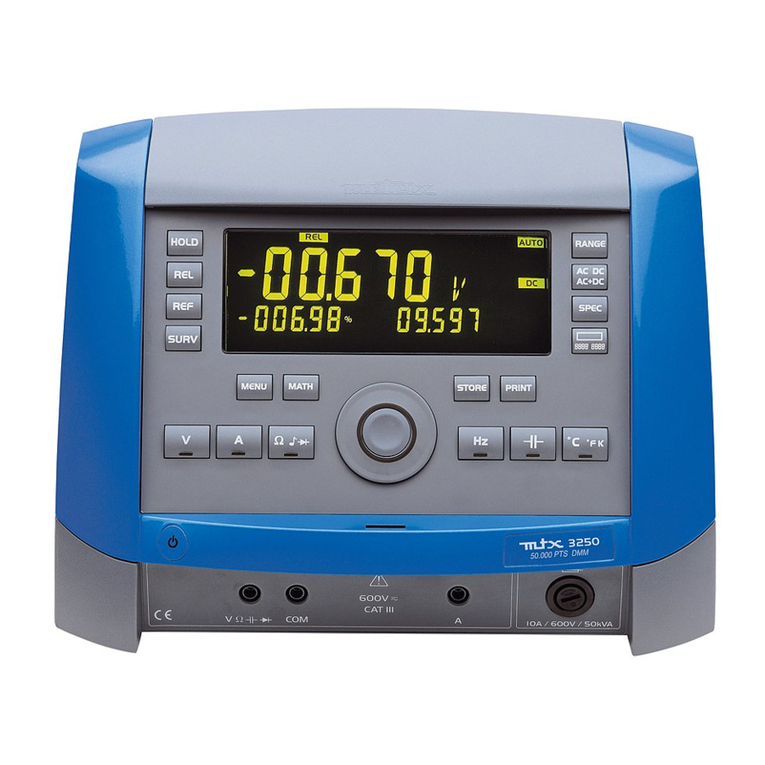
Metrix
Metrix MTX 3250 User manual

Metrix
Metrix MX 59HD User manual
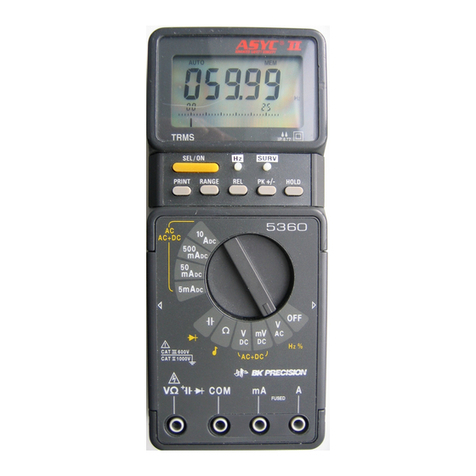
Metrix
Metrix MX 56C User manual
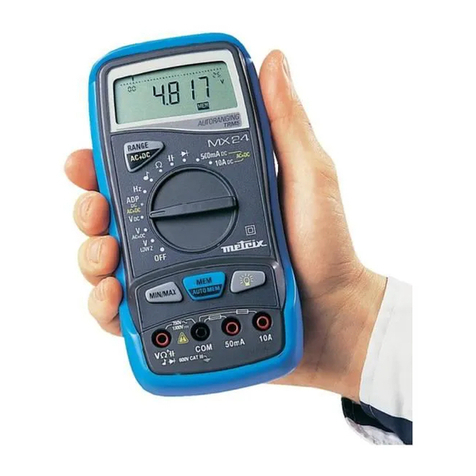
Metrix
Metrix MX 24 User manual
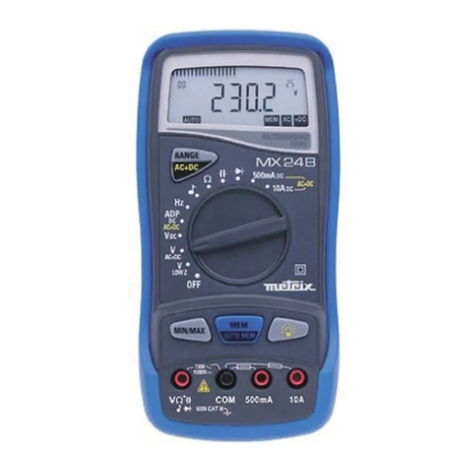
Metrix
Metrix MX 24B User manual
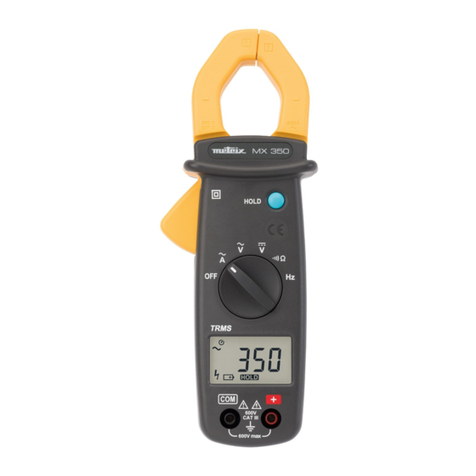
Metrix
Metrix MX 350 User manual

Metrix
Metrix MX 57 EX User manual
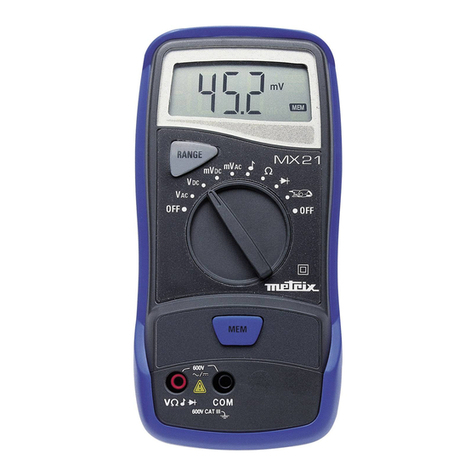
Metrix
Metrix MX 21 User manual
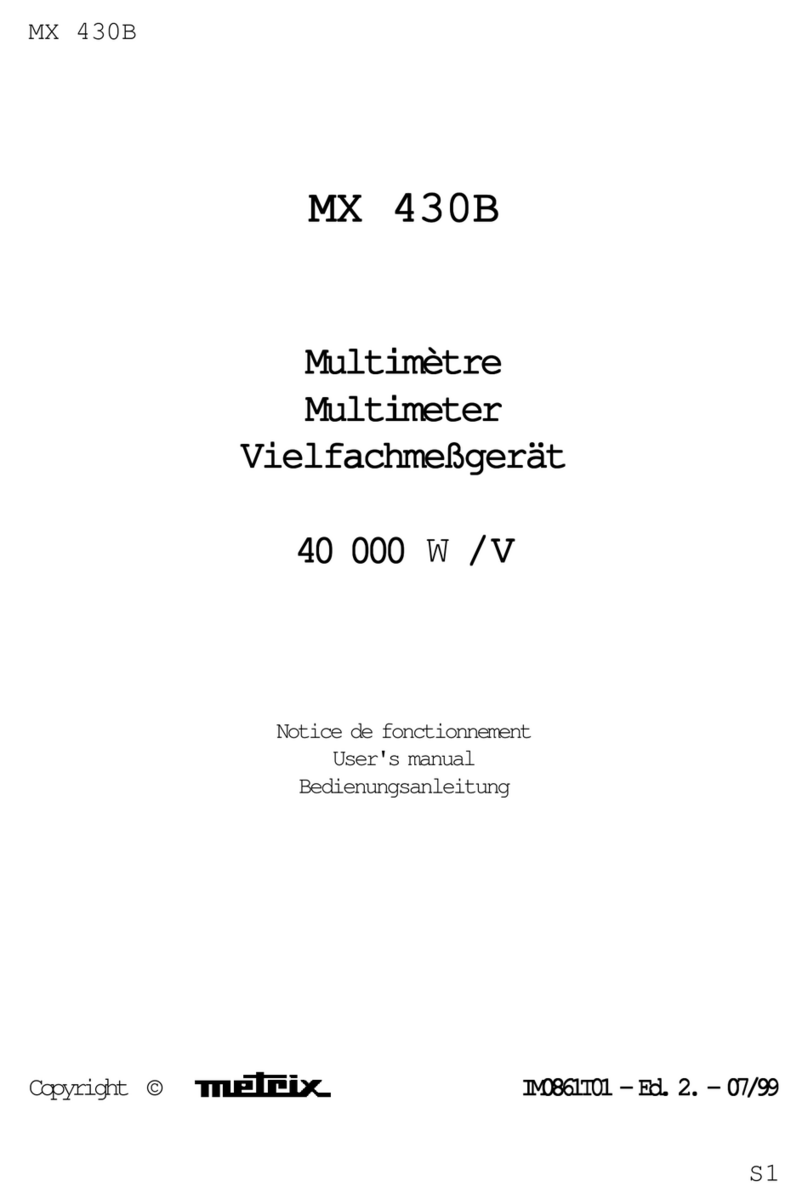
Metrix
Metrix MX 430B User manual
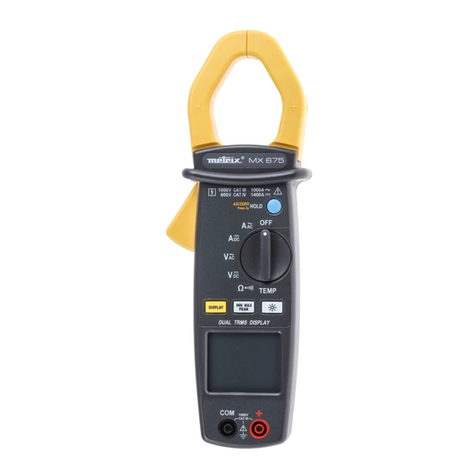
Metrix
Metrix MX 670 User manual
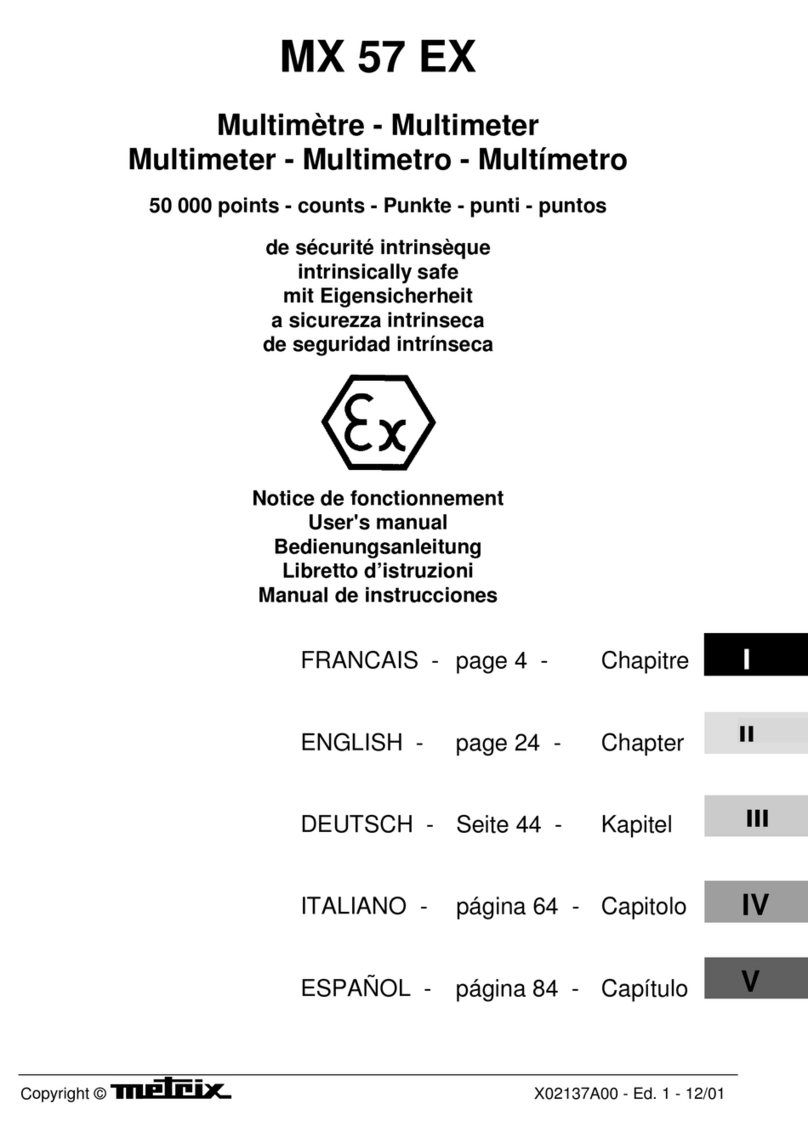
Metrix
Metrix Checkweigher User manual
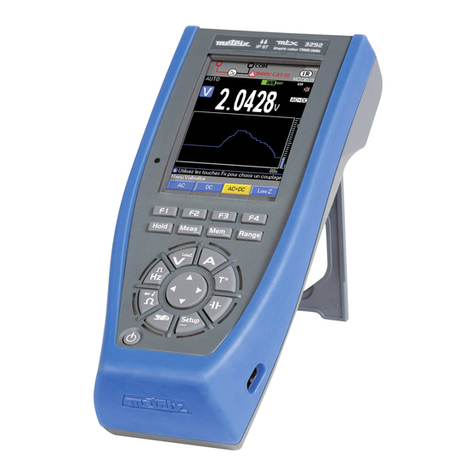
Metrix
Metrix ASYC IV MTX 3292 User manual
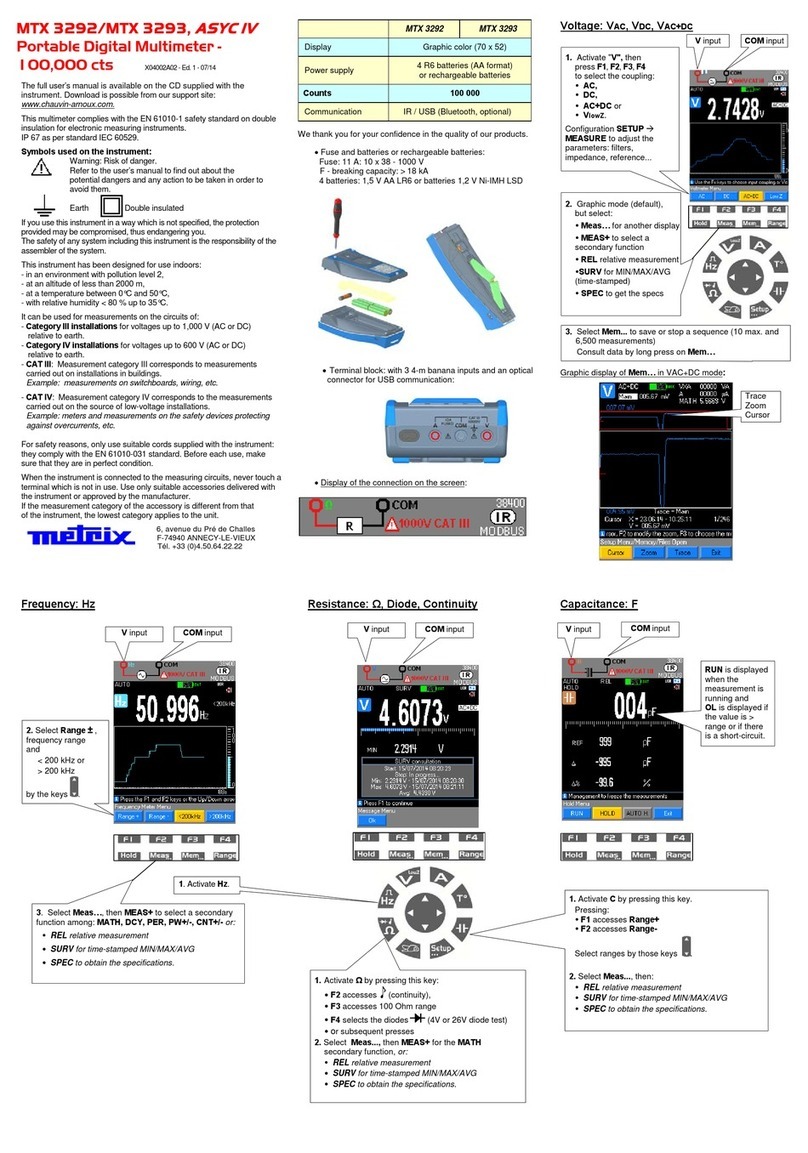
Metrix
Metrix MTX 3292 User manual
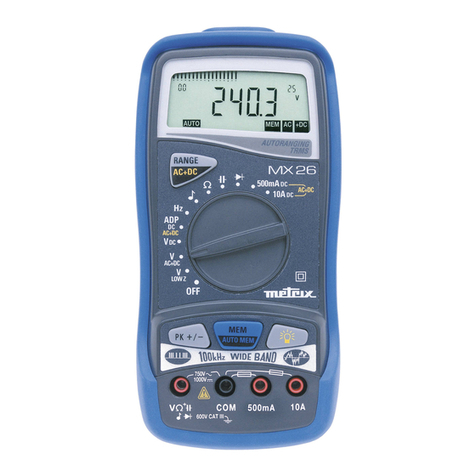
Metrix
Metrix MX 26 User manual
